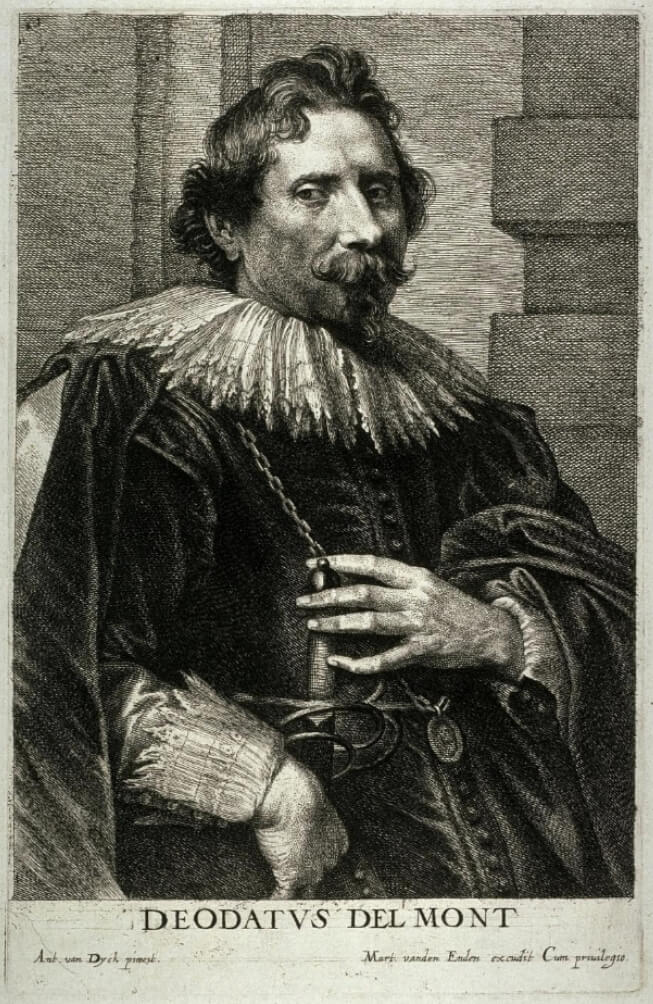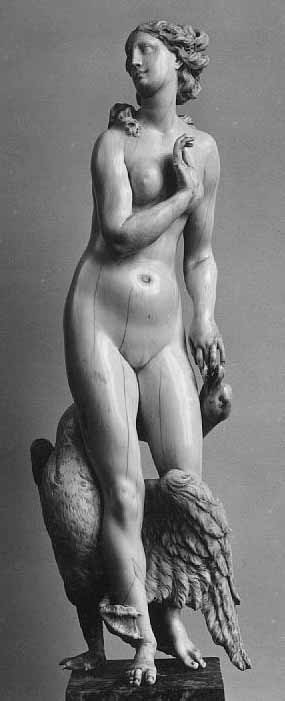RUBENS PUPILS
Deodaat Del Monte (or Deodat van der Mont)
Said to be Rubens’ close friend and very first pupil, Del Monte was five years junior to Rubens. He was a master in the study of art and the liberal arts. In 1600, he travelled throughout Italy with Rubens and was present when Rubens received several important commissions during these years. For example, he witnessed Rubens’ contract to execute Nativity which was commissioned for the high altar of S Filippo Neri in Fermo. It was highly probable that Del Monte assisted in many of Rubens’ works during these eight years of travelling around Italy, such as the Saint George and other Saints altarpiece for Santa Maria in Rome. He remained Rubens’ assistant until 1608 when he returned to Antwerp. He subsequently set up his own workshop in Antwerp. There are limited attributions to Del Monte’s own works.

Deodatus Del Mont, 16th – 17th century, Lucas Vorsterman the Elder, Image Courtesy of Fine arts Museums of San Francisco
Pieter Soutman
Soutman was a Haarlem born Dutch-artist, said to have worked in Rubens’ Antwerp studio after the workshop was renovated and expanded in 1615. He joined the studio in 1616, either as a pupil or collaborative assistance, and produced a significant number of prints and etchings that replicated other works by Rubens. These drawings were also used as preliminary designs for engravings of paintings. For example, an etching of The Rape of Proserpina (c. 1620 - 1628) by Soutman was modelled after an oil sketch by Rubens. The exact date of Soutman’s departure from Rubens’ studio is unknown, but he completely disassociated from the workshop when he left Antwerp in 1624.

Portrait Pieter Soutman, 1628, Anthony van Dyck, oil on canvas. Image Courtesy of Kunsthistorisches Museum.
The Abduction of Proserpina, ca. 1620 – 25, Pieter Soutman After Peter Paul Rubens, etching. Image Courtesy of The Metropolitan Museum of Art.
Erasmus Quellinus the Younger
Quellinus was born into a family of sculptors and little is known about his time as an apprentice. It is probable that he trained in Rubens’ studio but there is no documentary evidence of this. He enrolled as a master in the Guild of St. Luke between 1633 – 1634. Upon becoming a master, Quellinus became a frequent collaborator of Rubens. Quellinus was a masterful painter and he assisted Rubens in executing the Torre de la Parada paintings in 1636 – 1638. He was responsible for at least eight of the compositions in the series.
Quellinus was also a draughtsman, exceptionally skilled in drafting sculptural and architectural qualities. For this reason, Rubens often employed Quellinus’ talents to produce engravings of Rubens’ own creations. In 1637, Quellinus executed the print illustrations for Balthasar Moretus’s Officina Plantiniana. Rubens directed the iconography and layout of the book designs, while Quellinus produced most of the drawings under his instruction. The two masters collaborated in this way for many other works. Samson Fighting the Lion (1631) is another example of an etching that was invented by Rubens but executed by Quellinus. Subsequently, Quellinus executed several woodcut engravings and preparatory drawings that borrow from Rubens’ designs and iconography. It was common for these drafts to be used as modello for the commissioned works by other masters. The industrious production of Baroque Flemish art in Antwerp was indebted to this intricate network of cross-workshop collaboration.

Self-Portrait with his Wife Catherine de Hemelaer and Son Jan Erasmus Quellinus, ca. 1635 – 1636, Erasmus Quellinus the Younger, oil on canvas. Image Courtesy of Cincinnati Art Museum.

Samson Fighting the Lion, ca. 1635, Erasmus Quellinus the Younger after Peter Paul Rubens, etching. Image Courtesy of British Museum.
Theodoor van Thulden
Thulden was an Antwerp-based painter, draughtsman and print maker. He specialized in historical, mythological and literary scenes. Most notable were his dynamic human figures. There is no documentary evidence that Thulden was a pupil of Rubens, but his style and artistic choices exemplify strong influences from Rubens. Thulden produced prints that drew directly from designs and motifs of Rubens’ existing work. Between 1636 – 1638, Thulden assisted in painting the mythological decorations of the Torre de la Parada, based on the oil sketches made by Rubens. Two of the compositions in the series was executed by Thulden.
Lucas Faydherbe
Faydherbe was a painter and sculptor from Mechelen. In 1636, he travelled to Antwerp and became a pupil in Rubens’ workshop, where he mastered terracotta, ivory-carving and received some major commissions for tomb monuments. Under the instruction of Rubens, Faydherbe created the ivory sculpture Leda and the Swan, now held at the Louvre in Paris. Faydherbe remained in Rubens’ workshop for four years, and at times he oversaw the studio on behalf of his master. He left Rubens’ workshop in 1640. His independent oeuvre continued to exemplify strong influences and mannerisms of Rubens, even after the death of the master.

Smell (Portrait of Lucas Faydherbe), ca. 1661, Gonzales Coques, oil on oak wood. Image Courtesy of The National Gallery, London.

Leda and the Swan, n.d, attributed to Lucas Faydherbe, ivory. Image Courtesy of Louvre Museum.
Frans Wouters
Wouters is a Lier-born painter who first trained under Pieter van Avont before becoming Rubens’ pupil in 1634. He enrolled as a master in the Guild of St. Luke in 1635. In the early years of his independent career, Wouters assisted Rubens on several occasions. Under the instruction of Rubens, Wouters participated in designing the triumphal entry of the Cardinal Infante Ferdinand. He also assisted Rubens in completing Landscape with Cymon and Iphigenia (c. 1630s). Wouters was appointed the court painter of Emperor Ferdinand II of Vienna. His subject matter often focused on mythological and religious figures. He specialized in small cabinet paintings and took influence from the iconography and compositions of Rubens’ small landscape paintings. After the death of Rubens, Wouters was responsible for the valuation of the paintings in Rubens’ estate.

Portrait of Frans Wouters in Cornelis ‘Gulden Cabinet’, ca. 1662, Pieter de Jode II after Frans Wouters, etching. Image Courtesy of Rijksmuseum.

Landscape with Cymon and Iphigenia, ca. 1630, Peter Paul Rubens and Frans Wouters, oil on panel. Image Courtesy of Hermitage Museum.
Lucas Franchoys the Younger
Lucas Franchoys the Younger came from a family of artists in Mechelen. He was said to have enrolled as a pupil of Rubens in the 1630s and remained in the workshop till Rubens’ death. However, this information is widely disputed, and little is known about his supposed time at the workshop. Franchoys was a skilled painted, draftsman and print artist. Some preparatory drawings by Franchoys later in his career demonstrated possible stylistic influences from Rubens’ workshop but these are inconclusive speculations. For example, a head study drawing now held at the Metropolitan Museum of New York shows stylistic similarities to figures from Rubens’ Adoration of the Magi (1609). At the same time, it is possible that the head studies were drawn from live models.
Head Studies of a Young Man Wearing a Hat and of a Black Man, mid-17th century, attributed to Lucas Franchoys the Younger, chalk on paper. Image Courtesy of The Metropolitan Museum of Art.

Job seated on a dunghill between his wife and his three friends, ca. 1613, attributed to Nicholaas van der Horst after Peter Paul Rubens, chalk on paper. Image Courtesy of RKD Netherlands Institute for Art History.
Nicolaas van der Horst
Van Der Horst was a painter, draftsman and cartographer from Brussels, said to have trained at Rubens’ workshop for an unknown period. He worked mainly in oil paint and engraving, but the majority of his surviving oeuvre consists of prints. His subject matter was varied, focusing on allegorical scenes, portraits and designs after the works of other masters. A sketch of Job seated on a dunghill between his wife and his three friends (after 1613) is understood to be designed by Rubens and likely a practice drawing by Van Der Horst during his time in the School of Rubens.
Frans Luycx
Luycx was a master in the Guild of St Luke and worked at Rubens’ studio in 1620, either as a pupil-in-training or as an assistant. He specialised in historical scenes and portraits of figures. Scarce evidence survives from his time at Rubens’ workshop except some of his oil sketches, like The Annunciation of the Death of the Virgin, which suggest it was designed by Rubens. Luycx left Antwerp permanently in 1638 when he was employed as the court painter of Ferdinand III in Prague.

Frans Luycx (Self-portrait), ca. 1650, Frans Luycx, oil on canvas. Image Courtesy of Hradec and Moravici Castle.

The Annunciation of the Death of the Virgin, n.d., Frans Luycx, oil on canvas. Image Courtesy of RKD Netherlands Institute for Art History.
David Teniers the Elder
Teniers I was born into a family of drapers and studied under several masters. His first teacher was his brother Julian Teniers, before moving to study under Lisebetten and then finally Rubens. After completing his training at Rubens’ studio, Teniers left for Italy and returned to Antwerp in 1606, upon which he joined the Guild of St. Guild as a master. Having trained in Rubens’ workshop, Teniers was adept at historical and religious compositions but seemed to prefer landscape paintings. Most of his oeuvre consists of peasantry scenes.

Portrait of David Teniers I, ca. 1640 – 1678 and 1662, Peter van Liesebettem after Pieter van Mol, engraving. Image Courtesy of Rijksmuseum.
 Rubens Experts
Rubens Experts